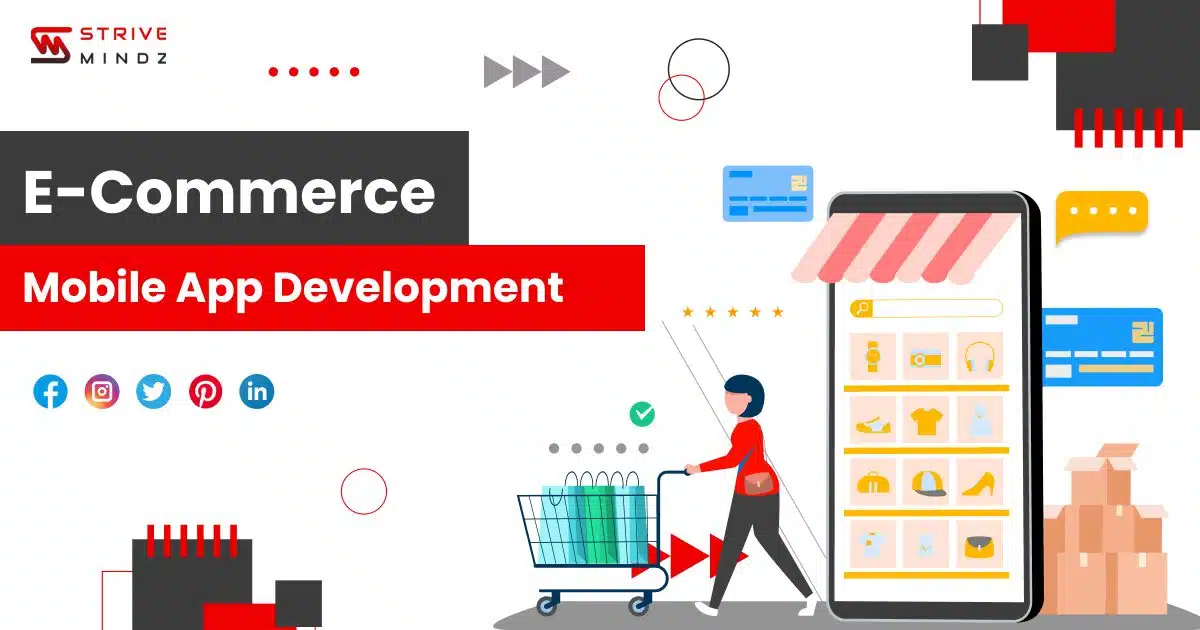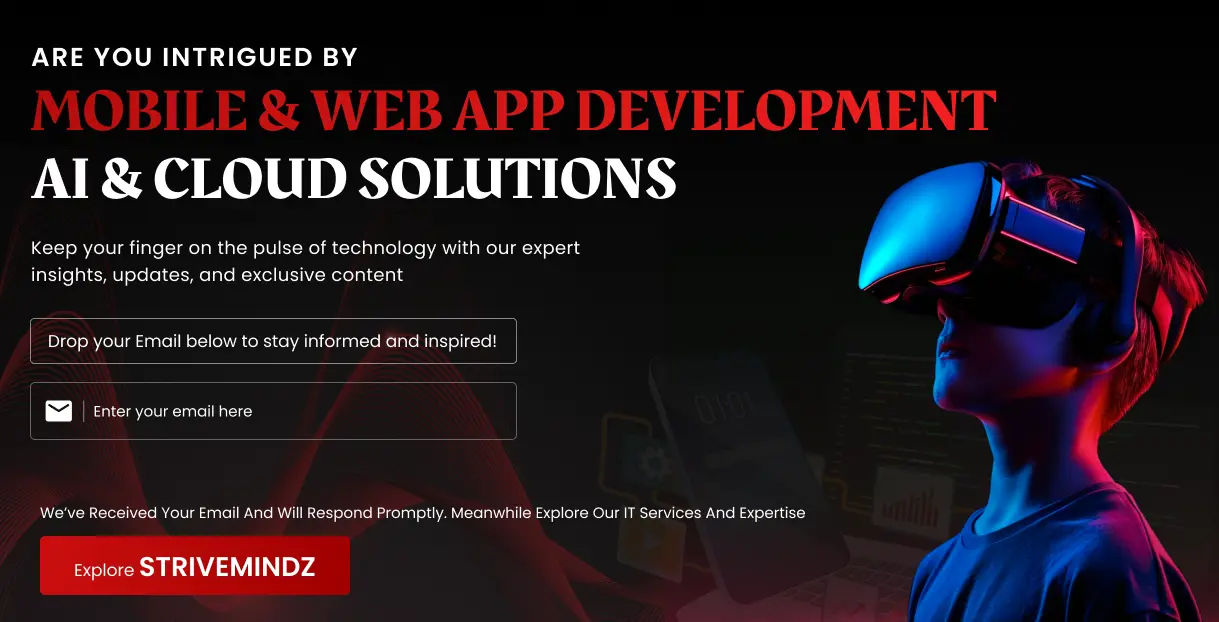E-commerce Mobile App Development: Key Feature & Costs

One of the most important demands, particularly for those who wish to dominate their field, is now a mobile device. Many business owners ask how much it will cost to build an eCommerce app because many users these days like mobile applications over other gadgets. To run any business, having a mobile app becomes essential.
The finest platform for generating global internet traffic is a mobile app. Using eCommerce applications to make purchases has become the most practical and popular method of buying. Strivemindz will summarize various processes for creating an eCommerce app similar to Amazon in this post, highlight eCommerce trends, reveal the approximate cost of developing a mobile commerce app, and list the characteristics your e-commerce app has to have.
Mobile commerce apps: What Are They?
Michael Aldrich, an English businessman, developed electronic commerce in its initial forms roughly 40 years ago. Though his concept wasn’t well received then, it eventually became a necessary aspect of our existence. When we refer to eCommerce, we imply the exchange of commercial items on internet markets. Simply use your computer or smartphone to conduct electronic transactions in order to purchase specified commodities and items. The e-commerce sector expanded even more due to technological advancement, globalization, and consumer demand for a large selection and an improved shopping experience. As a result, Brick-and-mortar stores must transition to an online presence in order to compete in the modern e-commerce industry. And here is where the creation of mobile e-commerce apps comes in.
Steps For Building An E-Commerce Mobile App
-
Research
Strivemindz employees are product nerds. That is why we gave the research stage top priority. In order to analyze the trends and behaviours of the target market, we conduct user interviews and competition research. It also helps define the perfect app platform and a feature set that appeals to our target audience as much as possible.
-
Set The Goals
The setting of your company’s goals forms the basis for developing an eCommerce mobile app. Here are three queries that aid you in setting goals:
- First, what issues are you attempting to resolve?
- To whom are you marketing this product?
- Finally, how can you tell whether it was a success?
-
Choose The Right Platform
Before choosing what technology to utilize for eCommerce application development, you need to become familiar with the inner workings of your company. Consider the inventory and development costs as you choose the CMS, database, and scalable framework. With this knowledge, selecting whether to release an iOS app, an Android app, or both is much simpler. Next, you must focus on the mobile platform that your target market uses. The right tech stack is essential for turning a great idea into a marketable product.
-
Define Feature Set
You already have feedback from customers, expert opinions, trends, and the desire to surpass your competitors, so you now have a better knowledge of the problems your product has to answer and the features that can please the end users. In addition, you can make use of well-known prioritization frameworks and methodologies to assist you in determining which product feature should be prioritized first.
-
Create UX & UI Design
UX & UI design offers the chance to differentiate eCommerce apps from traditional in-store experiences, as was already mentioned. For your target audience, the design will serve as both your voice and your brand’s identity. Color schemes, eye-catching graphics, and seamless page transitions leave a lasting impact on your customer.
-
Build MVP
You should concentrate on your eCommerce app’s most important features at the MVP stage. Strivemindz advises conducting continuing product evaluations that lead to fresh revisions rather than releasing a finished product right away. MVP aims to learn what customers think of the product, accelerate development, reduce risk, and make better use of available resources.
-
Gather Feedback
When the MVP is made available, it’s time to get customer feedback. Checking user interaction with your software, gathering user input, and looking for potential changes are all part of the process. Gathering user feedback is important when creating e-commerce applications since it enables you to determine what appeals to and repels your target market.
-
Iterate
Iterating comes last but not least. The best names in eCommerce app development will show us that design is never static. As a substitute, it is constantly evolving and modifying to satisfy user and market wants.
Key Aspects of Developing E-Commerce Mobile App
-
Single-Step Signup
A quick and easy registration or signup process is usually appealing to customers. Allowing customers to log in via email, phone numbers with OTP and even third-party accounts like Google and Facebook will simplify the registration procedure. In addition, the customer is pleased when there is a simple entry point to the online store. Fewer users abandon the app, and more purchases are generated when entry to the app is simple.
-
Advanced Search Functions
This function is intended for online shops with a significant product selection. Ensure that users can easily find what they’re looking for. Add sophisticated search features like sorting and filtering. Reduce the number of steps a customer must take to locate a product without looking through the entire store. This will undoubtedly boost conversion rates and provide satisfied customers.
-
Complete Product Specifications
Given the belief that attractive product photographs are sufficient to draw in potential customers, lengthy and thorough product descriptions could appear unneeded. But, no matter the platform, descriptions are important. What if a user of your app requests more information about the product? Do you really think they’ll bother to go to the desktop site in the first place? Descriptive product information also lowers the likelihood of impulsive purchases, client dissatisfaction, and product returns.
-
Augmented Reality
Augmented reality allows your eCommerce app to present your product to the user in a real-world setting. Although it has been accessible for a while, companies like IKEA have established augmented reality as a norm in online purchasing. Possessing a virtual try-before-you-buy experience is advantageous. Customers have found augmented reality useful when purchasing online because it removes questions and hesitations before making a decision. In addition, because it allows customers to use trial interactions to make deliberate decisions, it also helps to lower the churn rate.
-
Wishlist
A wish list is one of the key components you want in your mobile eCommerce app. Customers who are browsing can add their favorite products here. Buyers frequently return to them after purchasing some of the items on their wishlists. This encourages consumer loyalty and enhances customer return visits. In addition, customers enjoy adding things to their shopping carts without really purchasing them. Retailers can use the wishlist as information to remind customers and suggest products, which will ultimately lead to more sales.
-
Unique Customer Experience
Delivering pertinent product offers and recommendations to customers after they have finished browsing products of interest and made a purchase is advised. Nowadays, many retailers utilize highly developed recommendation systems to drive customization. It is easy to direct a customer’s attention to products, offers, and discounts that they find appealing, increasing the likelihood that they will make a purchase. Additionally, personalized content aids in boosting customer interaction with a brand and extending the business’s reach. Customers get more devoted as a result, and they are more inclined to visit your online store again. Although personalization has been around for a while, it is essential to use it effectively in eCommerce shopping apps.
-
Lightning-fast checkout
A speedy and simple checkout is required for your eCommerce mobile app because it is the last step in any conversion. Any contemporary eCommerce app must provide features like guest checkouts and automatic checkout details using profile information. The transaction must be completed by the user quickly and easily. It is essential to reduce concerns about cart abandonment.
-
Various Payment Options
Because different people prefer different payment methods, the eCommerce payment environment has grown highly diversified. Now, a few payment alternatives would not be sufficient. Google Pay, Apple Pay, and other lightning-fast and convenient payment methods are just a few of the available mobile app payment alternatives. In addition, if your eCommerce web store serves customers from several countries, the payment provider should also offer many currencies and international transactions.
-
Review of Products
Customers ought to access products and reviews like on an e-commerce website. Additionally, it’s crucial to allow customers to post merchandise reviews. In the eCommerce sector, customer feedback and reviews are a driving force. More information will enable buyers to choose their products and make an immediate purchasing decision. When a customer posts a positive or negative review, it makes them feel satisfied and builds transparency for the brand. Customer loyalty consequently rises as a result.
-
Orders and Returns Management
The ultimate goal of any eCommerce firm is to provide customers with an effective and seamless experience. To uphold this tenet, clients must be able to easily manage their orders using a mobile app, including tracking returns and deliveries. As a result, the customer’s sense of control over the purchasing process is increased. Additionally, this dramatically lowers the need for future customer support.
The Advantages of creating mobile applications for online stores
These days, mobile commerce is expanding rapidly. Mobile eCommerce solutions are crucial if you want to develop a profitable trading business and concentrate on bringing in clients and generating revenues. The necessity for a mobile solution in your webshop is actually driven by a number of factors.
- A mobile app is a replica of the company’s website, but it is highly optimized, customized, and well-designed, which enhances the user experience and makes it easier to attract and keep new customers. They arrive at a practical internet store where they may select products and pay for them without any hassle.
- Strong ties between brands and customers are supported through mobile apps. Users willfully exchange links to their favourite websites, solicit criticism, and talk about their shopping experiences on social networks. In addition, popular social networking sites can be incorporated into your application to enable client discussion of your goods and services. These are effective strategies for enhancing the image of your company, promoting your offerings, and grabbing the interest of prospective customers.
- Mobile applications are typically more adaptable and user-friendly. Despite the high cost of deployment, they will probably quickly pay for themselves and boost sales. It’s simple to understand how the two are related: a fantastic app with the appropriate functionality and design draws in more users, and more users result in more orders, which boosts your revenue. Additionally, push notifications are a cheap and efficient way to build brand awareness and boost sales. You may rapidly provide your clients with crucial information via push notifications, encouraging them to place immediate orders.
- Data tracking and gathering are easy within the application. Utilizing mobile capability enables you to monitor user activity and collect crucial information about them, including feedback, session length, audience demographics, and how responsive they are to various features and content. This might make it easier to distribute updates and improvements, make customized content, develop sophisticated marketing strategies, and run successful advertising campaigns.
- Thanks to the development of mobile contactless payment technology, cash and credit cards can now be replaced by individual smartphones. Apps for payments offer convenience, speed, and security. You can take out your coins, cash, and credit cards at the register without taking your wallet out of your purse. Simply place the phone next to the payment terminal. The COVID-19 outbreak has made it even more necessary for consumers to refrain from touching objects and strive to spend less time in stores.
What Is The Cost Of Developing An E-Commerce App?
The final component, the price of developing an eCommerce app, is now at hand. Entrepreneurs must evaluate their budget, manage their spending, and decide whether the risk is worth the reward at this level. It is difficult to give precise expenses when it comes to developing mobile eCommerce apps. First, everything is based on the objectives and specifications. For instance, the number of features, mobile platforms, the intricacy of the UI/UX design, etc. Second, the price varies according to a software development company’s location.
In contrast, app designer hourly fees in the US and Canada start at $150, whereas in Western Europe, they might range from $50 to $100. Rates in Eastern Europe range from $35 to $60, which are the best. Because of this, developing an eCommerce mobile application may cost you as much as $150K or even more. The upfront cost is challenging to estimate. Send us a message with any specific numbers you need regarding your eCommerce app idea and product requirements. You will receive thorough information from us.
Wrapping up
To cut a long tale short, several factors, including the widespread use of smartphones, the pandemic, consumer need for novelty, and other international situations, have contributed to the current growth in the eCommerce mobile app development industry. Your company has a lot of opportunities with an eCommerce app, from quick access to users to a competitive edge.
The leading players in the eCommerce sector were also examined, so you now know some trends to watch. Ultimately, developing an eCommerce app is all about putting the user first and coming up with the greatest user-friendly solution.
Contact Strivemindz if you are preparing to create an eCommerce app and need product help. With years of experience, we can design a solution specifically for your target market and product.
![E-commerce Mobile App Development: Key Feature & Costs E-commerce Mobile App Development Key Feature & Costs [Guide 2022]](https://www.strivemindz.com/blog/wp-content/uploads/2022/09/E-commerce-Mobile-App-Development-Key-Feature-Costs-Guide-2022.jpg)


